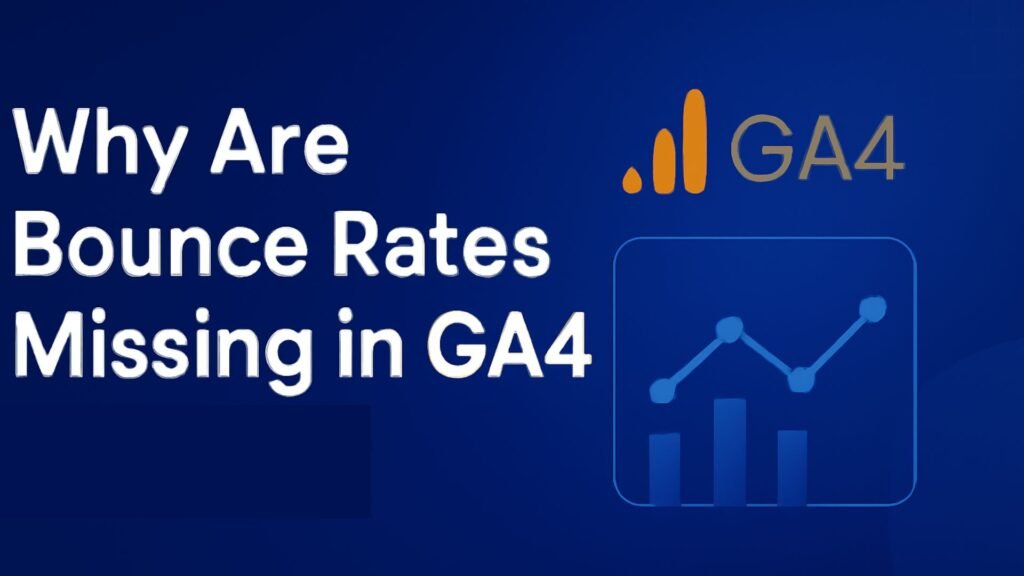Bounce rates are missing in GA4 because GA4 uses engagement metrics instead. Instead of bounce rate, GA4 tracks “engaged sessions,” focusing on active user interactions for more accurate insights.

Why Are Bounce Rates Missing in GA4?
If you’re used to Universal Analytics (UA), you might be searching for the bounce rate metric in Google Analytics 4 (GA4) only to find it missing.
GA4 was designed to provide a more modern and accurate view of user engagement, and part of this redesign was replacing bounce rate with new engagement metrics.
In this detailed explanation, we’ll explore why bounce rates don’t exist in GA4, what GA4 measures instead, and how you can use the new metrics to analyze your site performance effectively.
What Was the Bounce Rate in Universal Analytics?
Bounce rate in UA was defined as:
The percentage of single-page sessions where the user left without interacting further.
It was a simple metric, but had limitations because not all single-page sessions are bad. For example, a user who reads a blog post thoroughly but doesn’t click anywhere else would still count as a bounce.
Why GA4 Removed Bounce Rate?
Google Analytics 4 aims to move beyond the limitations of bounce rate by focusing on engagement rather than just “did the user click or not.”
Key reasons include:
1. Bounce Rate: Oversimplified User Behavior
Bounce rate doesn’t differentiate between a passive visit and an engaged visit on a single page.
2. GA4’s Event-Based Model Focuses on User Engagement
GA4 tracks engaged sessions—sessions where users:
- Spend at least 10 seconds on the site, OR
- Trigger a conversion event, OR
- View 2 or more pages/screens
This gives a clearer picture of user involvement.
3. GA4 Introduced New Metrics
Instead of bounce rate, GA4 provides:
- Engagement Rate = engaged sessions / total sessions.
- Engaged Sessions (sessions meeting engagement criteria).
- Average Engagement Time (time users actively spend on the site).
These replace bounce rate for more actionable insights.
How to Analyze Bounce-Like Behavior in GA4?
While GA4 doesn’t show bounce rate by default, you can approximate it:
- Bounce Rate ≈ 100% – Engagement Rate
If your Engagement Rate is 70%, bounce rate would be about 30%.
Can You Add Bounce Rate Back in GA4?
GA4 doesn’t provide bounce rate natively, but:
- You can create custom reports or explorations to calculate bounce-like metrics.
- Use Google Data Studio or Looker Studio to build visualizations with Engagement Rate or derived bounce rate.
- Some third-party tools offer bounce rate calculations from GA4 data.
What Does This Mean for Marketers?
Switching from bounce rate to engagement rate requires:
- Educating stakeholders on new metrics.
- Adjusting goals and KPIs to focus on engagement, not just clicks.
- Leveraging GA4’s richer user interaction data for smarter decisions.
Real Example
A content publisher noticed a high bounce rate in UA but found in GA4 that most sessions were actually engaged (time on page > 10 seconds).
This shifted their focus from “reducing bounce” to “increasing conversion events,” improving their marketing strategy.
How Socinova Can Help?
At Socinova, we guide businesses through GA4’s new analytics landscape.
If you’re missing bounce rate but want to understand user engagement better, we’ll help you set up custom reports, interpret GA4 data, and optimize your digital strategy.
Want help adapting to GA4? Contact us here and let’s improve your analytics together.
Conclusion
Bounce rate is no longer a default metric in GA4 because Google shifted its focus to engagement-based measurements that provide deeper insights into user behavior.
While bounce rate oversimplifies user interactions, GA4’s engagement rate, engaged sessions, and average engagement time offer a more accurate picture of how visitors interact with your site.
Marketers should embrace these new metrics to make smarter, data-driven decisions.
If you need help transitioning to GA4’s new framework or creating custom reports, Socinova can guide you every step of the way.




